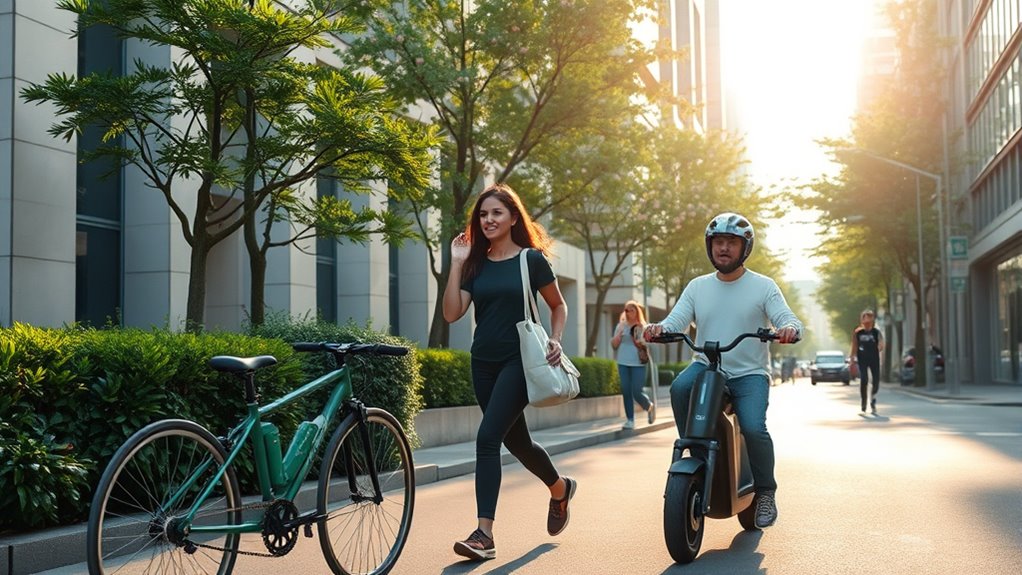Switching to eco-conscious commuting methods like public transit and carpooling is an easy way to cut your environmental impact. By sharing rides or using transit options, you reduce emissions, lower traffic congestion, and promote cleaner air. Planning your route and connecting with organized carpool programs can boost convenience and save money. Small changes in your daily routine greatly benefit your community and the planet. Keep exploring to discover more simple ways to make your commute greener.
Key Takeaways
- Use public transit options like buses, trains, or subways to reduce individual vehicle emissions.
- Carpool with coworkers or neighbors to decrease the number of cars on the road and lower environmental impact.
- Walk or bike for short trips to promote physical activity and minimize pollution.
- Choose routes and transit stops within walking distance to encourage active commuting.
- Support and advocate for eco-friendly transportation infrastructure and policies in your community.

Ever wondered how your daily commute impacts the environment? It’s a question worth asking because your choice of transportation can considerably affect your carbon footprint. Luckily, there are greener ways to get around town that not only help the planet but can also save you money and reduce stress. Two effective options are public transit and carpooling. Both are practical alternatives to driving alone and are designed to cut emissions while making your daily travel more sustainable.
Public transit, such as buses, trains, and subways, is one of the most efficient ways to reduce your environmental impact. When you use public transportation, you’re sharing a vehicle with many others, which means fewer cars on the road and less pollution per passenger. This collective approach helps lower greenhouse gas emissions and decreases traffic congestion. Plus, public transit often runs on cleaner energy sources, like electric or hybrid systems, further reducing its carbon footprint. Choosing to hop on a bus or train means you don’t have to worry about parking fees or the stresses of maneuvering traffic, making your commute more relaxed and predictable. It also encourages a more active lifestyle, as many transit stops are within walking distance, promoting walking or cycling as complementary activities.
Public transit reduces emissions, lowers congestion, and promotes active lifestyles with cleaner energy sources and shared rides.
Carpooling offers another smart way to make your daily travel more eco-friendly. When you share a ride with coworkers, friends, or neighbors, you cut down on the number of vehicles on the road. This not only lowers emissions but also reduces the wear and tear on your vehicle, saving you money on fuel and maintenance. Carpooling fosters a sense of community, and many workplaces even organize ride-sharing programs to facilitate connections. It’s a flexible option that can be tailored to your schedule, allowing you to choose routes and times that work best. Plus, by coordinating your commute with others, you can avoid the frustrations of solo driving and enjoy a more social, engaging start and end to your day.
Both public transit and carpooling require a bit of planning, but the benefits are well worth it. Not only do you lessen your environmental impact, but you also contribute to cleaner air and less traffic congestion in your community. Over time, these small changes in your commuting habits can add up to a considerable positive effect on the planet. Making the switch to greener transportation options is a simple yet powerful way to live more sustainably, and it’s something you can start doing today. Additionally, adopting these eco-friendly practices can encourage the development and expansion of eco-conscious transportation infrastructure, further enhancing sustainable travel options for everyone.
Frequently Asked Questions
What Are the Cost Benefits of Eco-Friendly Commuting Options?
Eco-friendly commuting options offer significant cost savings by reducing your fuel and maintenance expenses. You can also benefit from financial incentives like tax credits or subsidies for choosing greener transportation. Carpooling, biking, or using public transit not only cuts your daily costs but also helps you save money over time. Plus, choosing sustainable options often means fewer repairs and lower insurance premiums, making your commute more economical overall.
How Can Urban Planning Support Greener Transportation Methods?
Urban planning can support greener transportation by prioritizing public transit integration, making it easier and more efficient for you to choose buses or trains. Additionally, developing bicycle infrastructure encourages you to cycle safely and conveniently. When city layouts include accessible transit options and bike lanes, you’re more likely to opt for eco-friendly methods, reducing emissions and traffic congestion while promoting healthier commuting habits.
What Incentives Exist for Choosing Sustainable Commuting Options?
You can benefit from several incentives for choosing sustainable commuting options. Many workplaces offer employer subsidies to encourage biking, walking, or public transit use. Carpool programs also make it easier and more affordable to share rides, reducing your carbon footprint. These incentives not only save you money but also promote eco-friendly habits, making your daily commute more sustainable and socially responsible.
How Do Weather Conditions Affect Eco-Conscious Travel Choices?
Weather impact plays a big role in your travel choices, prompting seasonal adjustments. You might opt for public transit or biking less during heavy rain or snow, as these conditions make eco-friendly options less safe or practical. Conversely, clear, mild weather encourages walking or cycling, supporting your eco-conscious goals. Being aware of weather patterns helps you plan smarter, ensuring you stick to greener commuting methods regardless of seasonal changes.
What Are the Safety Considerations for Alternative Transportation Modes?
When considering alternative transportation modes, safety is key. You should prioritize bike safety by wearing a helmet, using lights, and obeying traffic laws. Pedestrian awareness is equally important; stay alert, make eye contact with drivers, and use crosswalks. Always check weather conditions that could impact your safety, like rain or fog, and adapt your route accordingly. Staying vigilant ensures a safer, eco-friendly commute every time.
Conclusion
By choosing eco-conscious commuting options, you reduce your carbon footprint and help protect the planet. Imagine biking to work through your vibrant neighborhood, feeling the fresh air and sunshine, while knowing you’re making a positive difference. For example, Sarah swapped her car for a bike and noticed her mornings felt more energized and peaceful. Small changes like these add up—so next time you head out, consider greener ways to get around and contribute to a healthier world.









